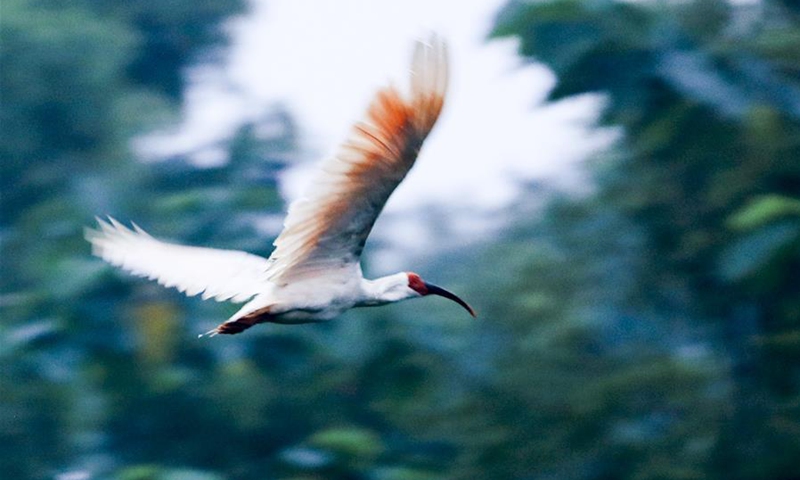Crested ibises seen near Chenjia Village in China's Shaanxi

A crested ibis flies near Chenjia Village of Yangxian County, northwest China's Shaanxi Province, Aug. 2, 2020. Crested ibises, with their iconic red crests and long black beaks, were thought to be extinct in China until seven wild birds were observed in Shaanxi Province in 1981, a discovery that prompted captive breeding and enhanced protection of the species. About 2,500 crested ibises live in Shaanxi with their habitat covering around 14,000 square km. (Xinhua/Lan Hongguang)

A crested ibis flies near Leicaogou reservoir in Yangxian County, northwest China's Shaanxi Province, Aug. 2, 2020. Crested ibises, with their iconic red crests and long black beaks, were thought to be extinct in China until seven wild birds were observed in Shaanxi Province in 1981, a discovery that prompted captive breeding and enhanced protection of the species. About 2,500 crested ibises live in Shaanxi with their habitat covering around 14,000 square km. (Xinhua/Lan Hongguang)

A crested ibis flies near Leicaogou reservoir in Yangxian County, northwest China's Shaanxi Province, Aug. 2, 2020. Crested ibises, with their iconic red crests and long black beaks, were thought to be extinct in China until seven wild birds were observed in Shaanxi Province in 1981, a discovery that prompted captive breeding and enhanced protection of the species. About 2,500 crested ibises live in Shaanxi with their habitat covering around 14,000 square km. (Xinhua/Lan Hongguang)

A crested ibis flies near Leicaogou reservoir in Yangxian County, northwest China's Shaanxi Province, Aug. 2, 2020. Crested ibises, with their iconic red crests and long black beaks, were thought to be extinct in China until seven wild birds were observed in Shaanxi Province in 1981, a discovery that prompted captive breeding and enhanced protection of the species. About 2,500 crested ibises live in Shaanxi with their habitat covering around 14,000 square km. (Xinhua/Lan Hongguang)

A crested ibis flies near Chenjia Village of Yangxian County, northwest China's Shaanxi Province, Aug. 1, 2020. Crested ibises, with their iconic red crests and long black beaks, were thought to be extinct in China until seven wild birds were observed in Shaanxi Province in 1981, a discovery that prompted captive breeding and enhanced protection of the species. About 2,500 crested ibises live in Shaanxi with their habitat covering around 14,000 square km. (Xinhua/Lan Hongguang)

Crested ibises are seen near Chenjia Village of Yangxian County, northwest China's Shaanxi Province, Aug. 1, 2020. Crested ibises, with their iconic red crests and long black beaks, were thought to be extinct in China until seven wild birds were observed in Shaanxi Province in 1981, a discovery that prompted captive breeding and enhanced protection of the species. About 2,500 crested ibises live in Shaanxi with their habitat covering around 14,000 square km. (Xinhua/Lan Hongguang)

A crested ibis flies near Leicaogou reservoir in Yangxian County, northwest China's Shaanxi Province, Aug. 2, 2020. Crested ibises, with their iconic red crests and long black beaks, were thought to be extinct in China until seven wild birds were observed in Shaanxi Province in 1981, a discovery that prompted captive breeding and enhanced protection of the species. About 2,500 crested ibises live in Shaanxi with their habitat covering around 14,000 square km. (Xinhua/Lan Hongguang)

A crested ibis flies near Leicaogou reservoir in Yangxian County, northwest China's Shaanxi Province, Aug. 2, 2020. Crested ibises, with their iconic red crests and long black beaks, were thought to be extinct in China until seven wild birds were observed in Shaanxi Province in 1981, a discovery that prompted captive breeding and enhanced protection of the species. About 2,500 crested ibises live in Shaanxi with their habitat covering around 14,000 square km. (Xinhua/Lan Hongguang)

A crested ibis flies near Chenjia Village of Yangxian County, northwest China's Shaanxi Province, Aug. 1, 2020. Crested ibises, with their iconic red crests and long black beaks, were thought to be extinct in China until seven wild birds were observed in Shaanxi Province in 1981, a discovery that prompted captive breeding and enhanced protection of the species. About 2,500 crested ibises live in Shaanxi with their habitat covering around 14,000 square km. (Xinhua/Lan Hongguang)

A crested ibis flies near Chenjia Village of Yangxian County, northwest China's Shaanxi Province, Aug. 1, 2020. Crested ibises, with their iconic red crests and long black beaks, were thought to be extinct in China until seven wild birds were observed in Shaanxi Province in 1981, a discovery that prompted captive breeding and enhanced protection of the species. About 2,500 crested ibises live in Shaanxi with their habitat covering around 14,000 square km. (Xinhua/Lan Hongguang)